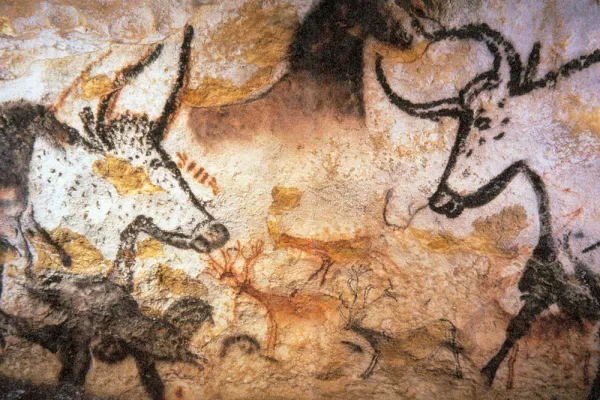Capitalism, Calamity and the Cultural Underground
Research & Inquiry

Published April 1, 2015
A probing interest in the history of what he calls “the logic of capitalism,” and how power is both expanded and challenged, drives the engine of Kevin Rozario’s scholarship. His first book was on calamity. The second, currently underway, examines cultural and political undergrounds, from the Stone Age cave paintings of southern France to contemporary digital hackers.
A historian by training, Rozario, an associate professor of American studies, established himself as a cultural critic with his analysis of America’s fascination with catastrophes, from those in the 17th century to Hurricane Katrina in the 21st. In his book The Culture of Calamity: Disaster and the Making of Modern America, Rozario, who directs Smith’s American studies program, shows that to constantly grow, a capitalist system depends on destruction to make room for whatever is next.
Disasters in the 20th century, like the San Francisco earthquake of 1906—an event that Rozario thoroughly analyzes—created horrible hardship for many of those who survived. On the other hand, investors saw such disasters as opportunities.
In the 21st century, as the country experiences the tightening grip of hypercapitalism—which Rozario defines as “a world in which everything has to be subjected to a calculus of profit or loss”—an event like Katrina strips away vestiges of self-determination in once vibrant neighborhoods. Redevelopment emphasizes short-term profit, he notes, at the expense of both cultural rejuvenation and sound planning for new environmental realities as temperatures rise and extreme weather events become more common.
“The Culture of Calamity shows that these events generally serve the powerful and affluent who capitalize upon crises to impose reforms that serve their interests,” says Rozario. “Disasters helped produce a national security state and entrench a capitalist system that depends on obsolescence, ruin and waste to enable the production of the new buildings, products and cultural forms upon which profits depend in a consumer society.”
Undeniably, this opportunistic response to disasters helps to account for some of the dynamic and inventive aspects of American development. The problem is that these political and economic developments also encourage behaviors that are themselves catastrophic. “If you have an optimistic view of destruction and disaster as an opportunity for more capitalist development and if capitalism is the thing that is damaging the environment and leading to climate change, it’s going to ultimately lead to more and more disasters. And that seems to be a vicious cycle,” says Rozario.
Ultimately, Rozario’s research led to an alternate focus on those who are left out or subordinated by dominant capitalist systems, and he turned to writing about the metaphorical underground as a place of cultural ferment in resisting the established order. The working title for his latest book, now underway, is, “Whatever Happened to the Underground? Cultural Innovation and Subversive Politics in the Age of Hyper-Capitalism.”
With this project, Rozario explores questions that have followed him through his scholarly career. “It is a sequel [to The Culture of Calamity] in the sense that I revisit opportunities presented by crises, but this time from below, from the point of view of those subordinated by dominant systems, those who seek to imagine and realize alternative ways of organizing society and doing business,” says Rozario. He is interested in new ways of being, new forms of artistic expression, new communities and new values that can save us from impending environmental and social catastrophes. “To go underground,” he says, “is to force a break with the conventional, the normal, the dominant, and to experiment in ways that allow for personal and social transformation.”
His scholarship goes back to a literal underground and the upper Paleolithic cave paintings of southern France. He notices that the Stone Age art embodies increasingly mythical and strange imagery the further from the cave entrances it is found. “The underground caves—dark, mysterious and apparently connected to the spirit world—are deranging spaces that, under the guidance of shamans, inspired artistic invention and frenzied rituals that gave positive value to wild creativity and release of passions,” he says.
“I spend a lot of time in this book writing about music, art and poetry,” says Rozario. This includes examining the works of Homer, Virgil and Dante. “Looking at classic literature of Western culture, we see that the underworld is an extraordinarily important and generative space associated with danger, threat and subversion, but also with vitality, creativity and innovation,” he continues. The Romantics of the 1800s and 1900s “were constantly looking below for alternative sources of value.”
After World War II, and especially by the 1950s and 1960s, the arts became “a privileged space for imagining alternatives to a media-driven mainstream culture that instructed society in ‘proper’ ways of behaving,” he explains. Beginning with the Beat Generation, associated with people like Jack Kerouac and Allen Ginsberg, “you have underground cinema and underground poetry; it’s a place you go to get away from dominant society,” says Rozario. “You go into a basement to watch a movie that’s going to ‘blow your mind’ so you can think in new and fresh ways.”
This impulse intensified during the counterculture of the 1960s, Rozario says. Take, for instance, the Weather Underground, a group of self-proclaimed revolutionaries who took their name from a lyric in the Bob Dylan song “Subterranean Homesick Blues.” (“You don’t need a weatherman to know which way the wind blows....”) The Weather Underground wanted to lead a revolution to combat what it perceived to be a civil war against African Americans in the United States as well as to challenge military actions overseas, and they looked to marginalized communities for ideas and innovative cultural expression that could inspire alternatives to dominant American culture.
In the past five years, Rozario has examined the emergence of what he calls a “digital underground,” exemplified by a loosely organized international network of hacker communities. The best known is Anonymous.
Groups like this frequently refer to themselves as being underground, says Rozario, “so even though we live in a flat, digital-networked world, they are still thinking in terms of vertical metaphors of up and down, high and low, above and below, as a way to think about how to use digital technologies to subvert an unjust surveillance society.”
Rozario doesn’t judge hackers who target computer networks. “I’m trying to figure out what actually happens when groups think of themselves as the underground,” he says. “It’s complex and sometimes contradictory. There are times when Anonymous is willing to take risks and go against dominant conventions to expose corruption and hold the powerful to account.”
By identifying themselves with the “underground,” digital activists claim a certain glamour that the mainstream media happily reinforces, Rozario notes. It gives them a “mystique” in their efforts to “imagine new kinds of politics and new kinds of activism aimed at thinking things through afresh.”
Photo credit: Photo by Prof saxx (own work) via Wikimedia Commons.
The Digital Underground
The dance between dominant narratives and the subversive currents of the underground takes on a paradoxical nature in the age of hypercapitalism, according to Associate Professor of American Studies Kevin Rozario. Commercial interests have become adept at appropriating the language, if not the ethos, of underground culture to promote consumerism.
This has been evident in the advertising industry for several decades and is taking on a new character in the digitally hyperconnected world of social media.
“I started studying underground culture to explore the prospects and possibilities of thinking outside the dominant capitalist way of thinking,” says Rozario. What he began to see is how “underground cultures not only get annexed by capitalism but become a fuel for capitalism.”
The history of rock and roll music is often cited as an example of an art form that grew out of a challenge to conventional thinking but eventually became embedded in the mainstream. But this isn’t news to Rozario. In addition to critiquing and researching culture, he sings and plays guitar in a band called Merchant Bankers—a local group that performs country-inflected, alternative pop, for which he wrote a song called “Gold.” That song includes the line, “Rock and roll used to be countercultural now it’s just capital accumulation.”

Kevin Rozario
The youth culture that grew out of the latter half of the 20th century was driven in part by a quest for social justice, racial equality and a cleaner environment. The urge was to “look for new values,” says Rozario. In the 1980s “businesses looked to the underground for cultural forms that seemed authentic, edgy and exciting.” That impulse has evolved into “corporations trying to sell stuff to people who don’t like corporations... [by] capitalizing on their desire for something authentic, radical and rebellious.”
As he continues to investigate underground expressions of cultural innovation, from Stone Age cave art to the present day, he sees similar dynamics playing out in a communications milieu that is increasingly saturated by social media.
These observations fit with his drive to determine where the challenges to hypercapitalism are brewing today. Says Rozario, “I am really interested in how social media and digital technologies have changed our prospects for rethinking culture, rethinking values and producing social change.”
The literal underground can take many innovative forms, from the upper Paleolithic cave paintings of southern France to the contemporary hyperconnected world of social media.